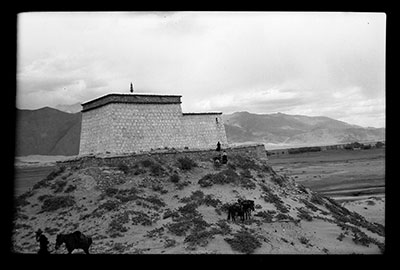
2001.59.13.44.1 (Film negative)


2001.59.13.44.1 (Film negative)

Hugh E. Richardson
Hugh Richardson
1949
Tsangpo Valley Region > Kacu
2001.59.13.44.1
85 x 60 mm
Negative film nitrate
Donated August 2001
The executors of the estate of Hugh E. Richardson
Richardson's 1949 tour of the Yarlunng and Chyongye valleys
‘High Peaks, Pure Earth’, Hugh Richardson, London, Serindia Publications, 1998 [view list of illustrations]
Manual Catalogues - Notes on negative album - 'NYEMO. SAMYE. YARLUNG. RGYAL.' is written on the cover of this blue negative album in white in Richardson's hand. [KC 24/3/2006]
Manual Catalogues - Notes on Blue negative album index - No. 44. 'Kha ru lhakhang'.
Manual Catalogues - Richardson's handlist: 'Blue Album. [No.] 44. 'also' [Small temple to the east of Bsam yas, behind the Has-po-ri, called Has-po rgyab, said to date from the time of the Kings and to be contemporary with Bsam-yas].
Research publication - H. E. Richardson, High Peaks, Pure Earth' , London, Serindia Publications, 1998, plate 64. "Kwa-cu." [KC 09/11/2006]
Other Information - Location: Richardson mentions this temple in High Peaks, Pure Earth , London, Serindia Publications, 1998, p. 317. "... and some miles further east [of Ha po rgyab] on a small hillock overlooking a little pool was Kwa-cu (1949), a similar, single-storey white temple, possibly eighth or ninth century, with images of the Religious Kings in it."
Technical Information - This photograph was taken using a Zeiss Super Ikonta camera which could take images of 6x9 cm. This was the largest negative exposure size that Richardson could take advantage of with the two cameras that he owned (the other being a Reflex Korelle, which 6x6 cm images). This size produced contact prints of sufficient size that they could be used as prints without further enlargement. However, it was only possible to take 8 images per role with this size of image. By the late 1940s, generally Richardson seems to have used this size image less and less and the choice on this tour probably reflects the significance of the site and the fact that Richardson wanted to take readable photographs of the inscription pillar there, as previously he had relied upon copies made available to him by Sir Charles Bell [ A Corpus of Early Tibetan Inscriptions , Royal Asiatic Society, James G. Forlong Series, No. XXIX, Hertford: Stephen Austin & Sons Ltd, 1985, p.26] [MS 17/12/2005]
Other Information - Dates: Richardson states that he photographed the Samye inscription pillar in 1949 [ A Corpus of Early Tibetan Inscriptions , Royal Asiatic Society, James G. Forlong Series, No. XXIX, Hertford: Stephen Austin & Sons Ltd, 1985, p.26] [MS 17/12/2005]
For Citation use:
The Tibet Album.
"Temple of Kacu near Samye"
05 Dec. 2006. The Pitt Rivers Museum.
<http://tibet.prm.ox.ac.uk/photo_2001.59.13.44.1.html>.
For more information about photographic usage or to order prints, please visit the The Pitt Rivers Museum.
© The Pitt Rivers Museum